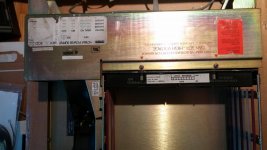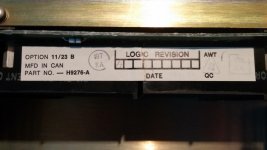This thread has been going on for so long starting to forget where we are! being old and senile don’t help either. Let me try to review what you do have and what you don’t.
First off don’t think there is any big issue what backplane you are using if you have simple cards like the 8186 CPU, 8044 memory and 8043 SLU stuffed into the left hand side of the system, ok- so I know everyone is going to jump up and say what if it’s one of those weird AB/AB backplanes but myself have never seen one and think they are all ABCD so stuffing everything in the left side with CPU on top , SLU second and memory third is a good way to go. Regardless of it being 16, 18 or 22 bit.
The 8012 bootstrap terminator goes in the last or bottom of the card cage.
Second, you have the con up and what’s it telling you? In ODT can you look at the contents of registers? (R0 to R7) and input changes? When you enter addresses can you view the contents of those locations and make changes? Somehow recall that if there is no working memory in the system you can still stomp around in the registers and see and change them so that kind of lets you know ODT and the CPU are alive and think you were at that stage but if you can’t go to a memory address like L1000 and see (E) or change(D) its contents you’re not getting any love from the memory cards. Also did you check the address set on the memory cards? Your first card should be all ones or all zeros. Know that’s not real helpful but do recall on card one all the address switches are set the same way.
Third once ODT is good and you can load memory contents load stupid loop program and will that work? I have a web page that has a copy of the test loop program along with a lot of ODT info at:
http://staff.salisbury.edu/~rafantini/PDP11Octaltricks.htm
It’s all simple stuff but if you can’t do that stuff forget trying to load operating systems or XXPD and the like.
What are the lights on the back of the BDV-11 (8012) saying? The green LED is just a “power OK” but the four red LED can tell you a lot. Looking at the LED on the card bit 0 is closest to the two switches, then bit 1, bit 2 the green power ok LED and then bit 3 Normal operation in ODT waiting for a input will be bit 2 on all other off, if bit 1 is on and all other are off that indicates a memory error and the address of the faulty section of memory will be deposited in R1, if all the LED are on then you have the system hung at a location, bootstrap error or the halt switch set to the wrong position. Remember the BDV11 is your friend.
Hope this is not an overstatement of the obvious or two simplistic but you have been working on this for a while now and I am not one hundred percent on just where you are.


